This pictorial shows steins from the artistic
period known in Germany as Jugendstil. This compound word literally means
"youth style" or "young style", and the name is derived from
a very popular Munich periodical which began publishing in 1896.
Stoneware firms in the Westerwald made a definite shift in artistic style
just as the 20th century was beginning. Steins began to appear with
non-traditional shapes. Decorative styles of the past gave way to simple lines
or abstraction. Natural plant forms provided much inspiration. Polychrome
illustration yielded to simple blue-gray or brown glazes, or when glaze painted,
a simple color scheme was generally used.
This article will provide an introduction to the products of several
Westerwald firms who were significant producers of Jugendstil steins:
- Reinhold Merkelbach, Grenzhausen
- Simon Peter Gerz, Höhr
- Reinhold Hanke, Höhr
- Marzi & Remy, Höhr
- Merkelbach & Wick, Grenzhausen
[Note: All of these photos are "clickable", in order
to show a larger image or other variations of the same or related pieces.]
| This mug and the jar (pitcher,
or pouring stein) were made without lids according to manufacturer catalogs, and
were designed by the world famous Art Nouveau designer Henry Clemens van de
Velde in the year 1902 for Reinhold Hanke. These are marked on the base with the
form number (1428) and the monogram of the designer. |
 |
| This stein won the first prize
in a student competition for drinking vessels held in the year 1908 by the Landesgewerbemuseum
in Stuttgart. Designed by Herta Kasten, it was produced by Reinhold Merkelbach
as form 2085. The words Gaudeamus Igitur, taken from a popular student
song, appear on the body in relief, and at the top of the handle in relief is a
symbolic owl. |
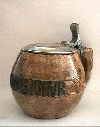 |
| This nice stein was designed by
Leonhard Hellmuth, a teacher of a design school in Ansbach. The stein is from a
beautiful series of steins, pitchers and vases he designed in the year 1904 for
Reinhold Merkelbach. The bottom is incised with the artist's "LH"
monogram, and the model number 6. |
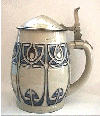 |
| This lovely stein was designed
by Bruno Mauder for Simon Peter Gerz. Professor Mauder was later the leader of
the school for glass design in Zwiesel. The base is incised with the Gerz
trademark (triangle surrounding a master stein) and the form number 1339. |
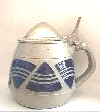 |
| The relief of this 1 liter stein
with the typical Bavarian shape was designed by Franz Ringer, an artist from
Munich. Ringer is well known for the steins he produced for Villeroy and Boch in
Mettlach, but this one, form 2097, he created for Reinhold Merkelbach in the
year 1908. The stein with its funny motif was so popular that production was
renewed in 1926. But instead of this early saltglazed stoneware (ca. 1910) the
later ones were made of pottery. The saying on the stein, "Ich sing mein
Lied so gut ich kann" translates to "I sing my song as well as I
can". Ringer designed a group of steins with humorous scenes and they are
much sought by collectors. |
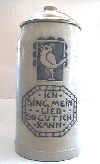 |
| This nice colored pottery stein
was designed by Karl Görig. First a teacher at the school for ivory carving in
Idar-Oberstein, he moved to Darmstadt after retiring. The saying on this stein,
executed by Marzi & Remy, is "Trink gut und rein, zuviel lass sein!",
which means "Drink good and clean, but not too much!" The base of the
stein, ca. 1904, shows the form number 1773. |
 |
| This one was produced by Marzy
& Remy about 1908 and has model number 2006. |
 |
| This stein was designed by Paul
Wynand for Marzi & Remy about 1909/10. Its decoration is a nice combination
of the kölnischbraun glaze with the cobalt blue circles. The model
number is 2186. Wynand worked mainly as a sculptor and his bronzes are often
found in German cities. |
 |
| This saltglazed stein has very
typical ornaments. I would say their origin is in Darmstadt, whose world-famous
group of designers were among the most important contributors to Jugendstil.
This funny stein was produced by Merkelbach & Wick. The bottom is incised
with their trademark. The form number, 2145, appears under the handle. |
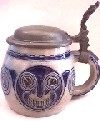 |
| This stein, which I would call a
Bavarian Art Nouveau style, was designed by a teacher named Schmidt, about whom
we know nothing else. He designed it for Reinhold Merkelbach in 1902. The model
number is 1736. |
 |
| The designer of this colored
pottery stein was Leonhard Hellmuth. It's another beautiful example from the
line he designed for Reinhold Merkelbach in 1904. The base shows the artist's
"LH" monogram and the model number 1. |
 |

